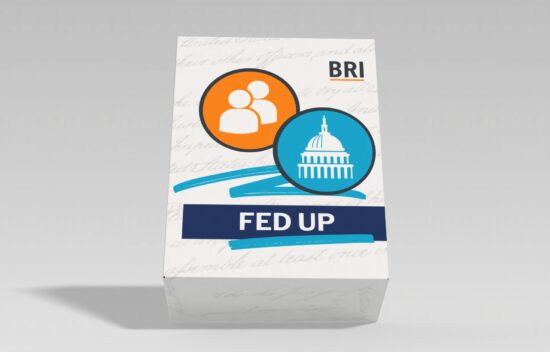
Sorting Views of the Federalists and Anti-Federalists
Guiding Questions
- What were the principles of the new Constitution and how did they shape the debate between the Federalists and Anti-Federalists during the ratification debate?
- What were the key arguments for and against ratification of the Constitution, and how were the debates shaped by constitutional principles?
Objectives
- Students will use recently acquired knowledge to sort views and opinions of the Federalists and Anti-Federalists.
- Students will consider the dialogue, compromise, and contention surrounding the ratification of the constitution.
Student Resources:
- Federalist or Anti-Federalist Sort Handout
- Principles of the Founding Primary Source Set
- Highlighters (3 colors)
- Scissors and glue
Facilitation Notes
- This lesson plan is scaffolded to give students the arguments of the Federalists and Anti-Federalists in the debate surrounding the Constitution and Bill of Rights. If your students require more challenge check out the following activities from other BRI curriculums:
- Federalist and Anti-Federalist Venn Diagram
- Were the Anti-Federalists Induly Suspicious or Insightful Political Thinkers
- Understanding Positions of Federalists and Anti-Federalists
- Federalists and Anti-federalists Debate Congressional Powers
- Anti-Federalist Objections to the Constitution
Anticipate (Optional)
Glossary term(s): Federal, executive, republic, constitution, liberty, representation
- Review with students the basics of the debate between the Federalists and Anti-Federalists and the Articles of Confederation. Create a reference chart on the class board surface to organize main ideas and themes.
- Articles: Weak federal government, weak connection between states, led to issues with trade, funding a national defense, and keeping peace.
- Federalists: Supported the new Constitution, stronger national government, energetic executive, extend the sphere of government, limit the power of factions
- Anti-federalists: Concerned about the new Constitution, stronger state governments, weak or no executive, only small republics can represent the people/preserve liberty, wanted a Bill of Rights
Scaffolding note: If students need a refresher on the problems with the Articles and what the Constitution includes, consider sharing our BRI Jr. Development of the Constitution video. It puts these concepts in very simple terms in under 6 minutes. You can then extend the video by outlining that not everyone liked the plan for the Constitution. Overview the concerns of the Anti-Federalists and the Federalist response using the bullet points above to create the reference chart.
Engage
Glossary term(s): taxation, republican government/republic, representatives, checks and balances
- Transition: Distribute Federalist or Anti-Federalist Cut and Paste handouts to each student. Also ensure students have scissors, glue, and pencils available for their task.
- Review the instructions and expectations for the cut and paste handout and ensure a brisk pace for this activity.
- Set a timer for 5-7 minutes and allow students to use the reference chart on the board and their partner to sort the views of Federalists and Anti-Federalists.
- Quickly review target responses in a whole-group check.
Explore
Glossary term(s): natural rights, equality, justice
- Transition: Distribute copies of the Primary Source Handout Set and give instructions for students to pull out three different color highlighters for the next stage of the lesson.
- Tell students: “Next, we will be looking at some primary sources from the Federalists and Anti-Federalists as well as the Constitution, Articles of Confederation, and Declaration of Independence. We are going to consider how the Declaration, Articles of Confederation, and Constitution were all aiming for the same principles.”
- Write on the board, “What evidence exists to support the statement: The Declaration of Independence, Articles of Confederation, and Constitution were all aiming for the same principles- natural rights, equality, and justice.”
Scaffolding note: Review with students, post, or distribute copies of BRI’s Principles and Virtues so that students have definitions of natural rights, equality, and justice to work with.
- Ask students to use their highlighters to color-code the principles in each short excerpt. For instance, yellow for natural rights, pink for equality, and blue for justice.
- Give students 20-30 minutes to work through the short primary sources grouping and color coding the sources. There is one Federalist paper excerpt, two Anti-Federalist Brutus excerpts, and an excerpt from the Articles of Confederation, the Constitution, and the Declaration.
Scaffolding note: To abbreviate the assignment, a student might be assigned one Federalist paper, one Brutus excerpt, and either the Articles of Confederation, Declaration, or Constitution excerpts. Students could be assigned to groups and assigned one document to color-code, then share with the class.
- When students finish the activity, return to the statement on the board and lead a class discussion to share the evidence students found.
- Continue the conversation by asking students to reflect on the ways that these divergent ideas and opinions were all fueled by the same principles.
- All of these documents were written by the same generation of people. They hoped to build a government around shared principles because there was little else to unite early Americans. Just like today, there were various states, religions, languages, cultures, and values represented in the early United States.
- Finish the conversation by helping students connect these ideas to today.
- For instance, most Americans agree the United States debt is too high, but we disagree on how to solve the debt crisis. We can still agree on an outcome, without agreeing on the solutions to get us there.
Assess & Reflect
- Color-Coding Application
- Ask students to repeat the color-coding process to analyze the extent to which the Federalists and Anti-Federalists agreed about the principle of limited government.
AND/OR
- Reflection Prompt
- How can different opinions in a conflict be based on the same or similar principles and views? Give an example supported with evidence.
Extend (Optional)
- Would you have been a Federalist or Anti-Federalist Interactive
- Play Modified Fed Up: Whole-Group Version, a Scaffolded and virtual version of the prognostication opinion card game that immerses students in a simulation of the Federalist vs. Anti-Federalist debate.
